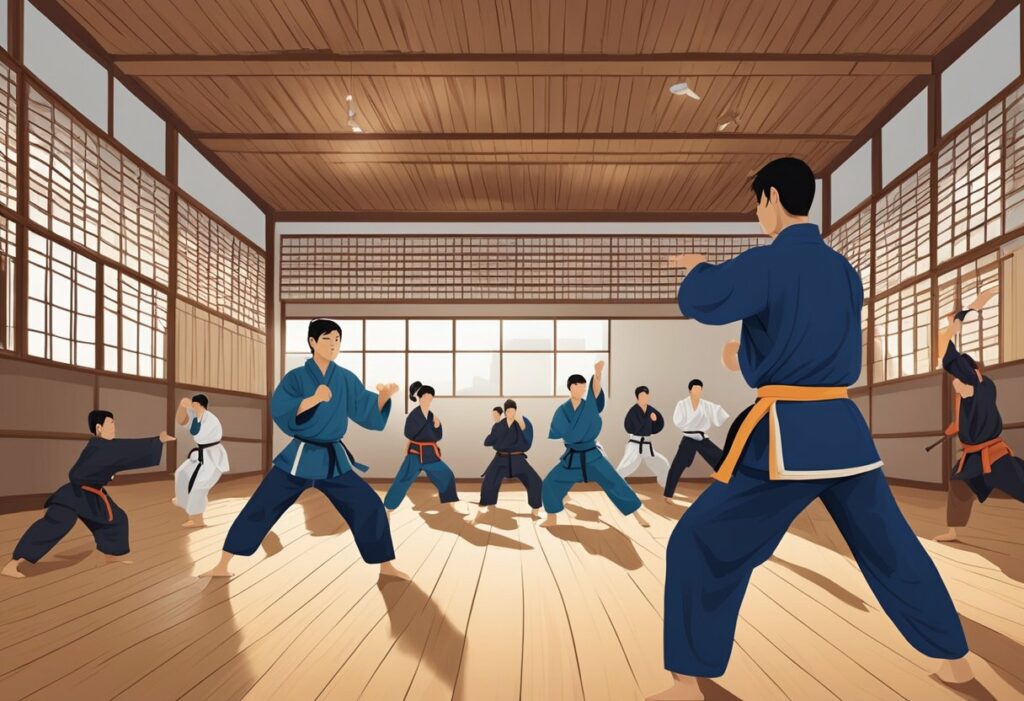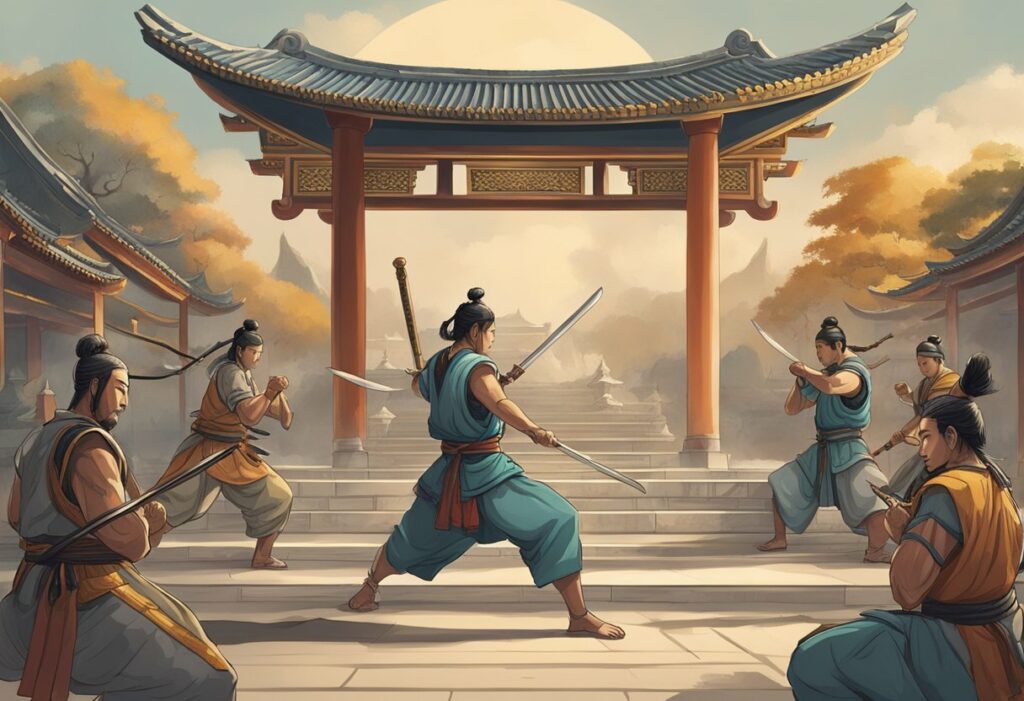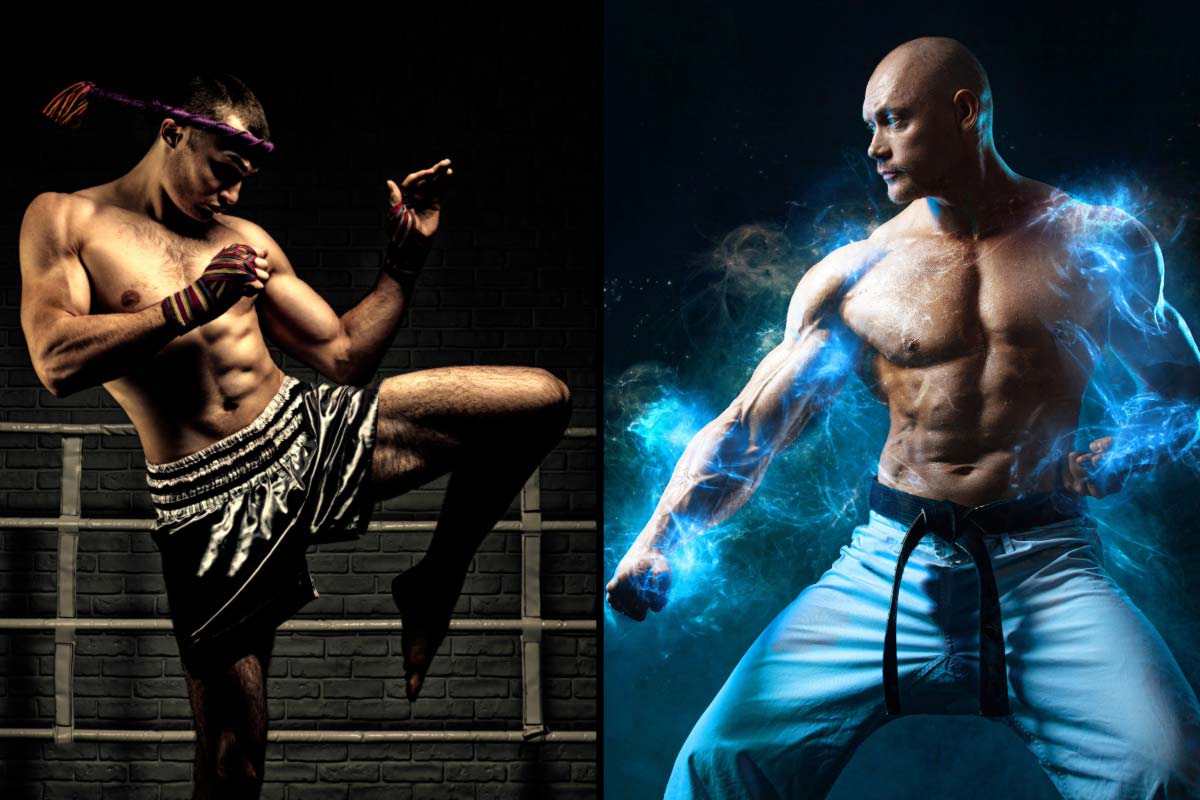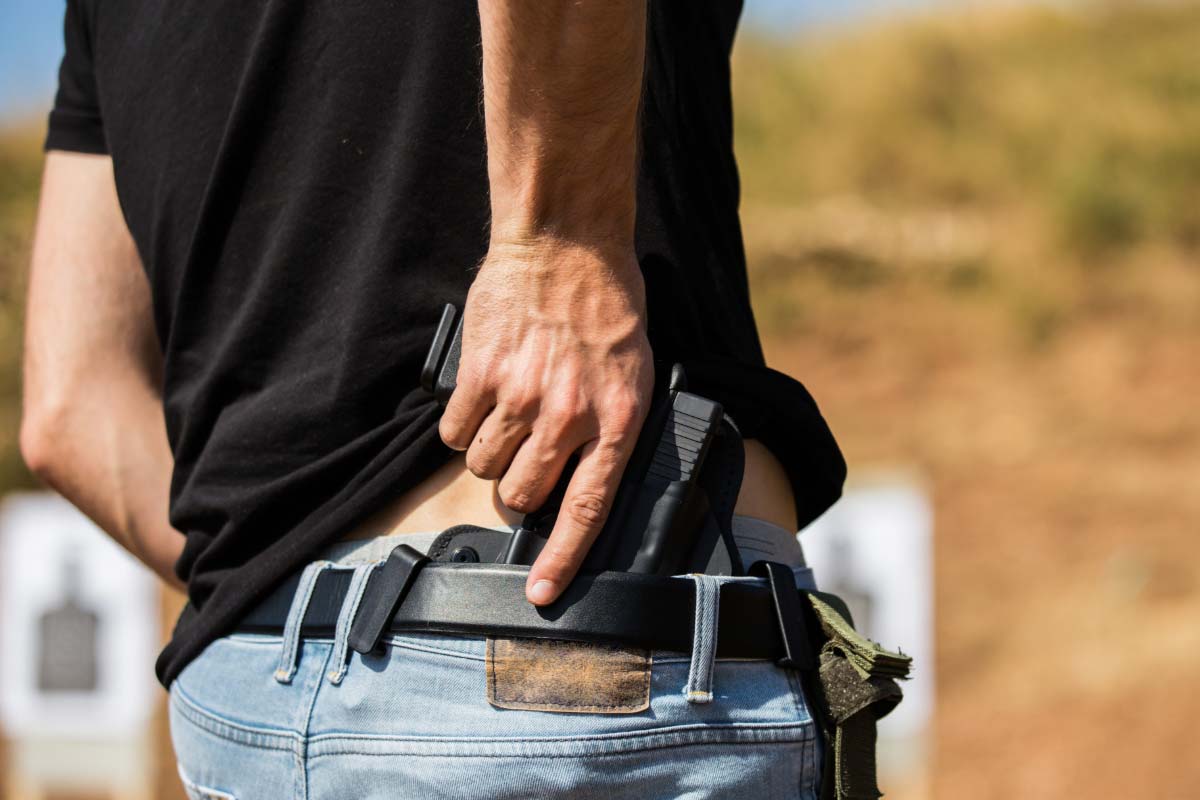Determining the most effective martial art is a complex endeavor, as it often depends on individual goals, situations, and physical capabilities.
Historically, martial arts have evolved from different global cultures, each with its own unique techniques and philosophies tailored to the environments and challenges of their time.
In the modern context, martial arts are not only a means of self-defense but also a way to enhance physical fitness, mental discipline, and cultural understanding.

When analyzing martial arts effectiveness, one must consider the diverse range of styles, including striking and grappling disciplines.
Striking arts such as Muay Thai and boxing emphasize powerful punches and kicks, while grappling arts like Brazilian Jiu-Jitsu and wrestling focus on ground techniques and submission holds.
Multidisciplinary approaches, such as mixed martial arts (MMA), combine elements from various systems, highlighting the importance of versatility in combat situations.
The choice of martial art may also be influenced by its self-defense effectiveness. Self-defense systems like Krav Maga are developed specifically for real-world confrontational scenarios, while others might concentrate on spiritual growth or competition.
The most suitable martial art varies based on personal needs, whether for protection, competition, or personal growth.
Key Takeaways
- Martial arts effectiveness is subjective and based on personal goals.
- A variety of styles exist, each with distinct techniques and strengths.
- The optimal martial art may differ according to self-defense needs and personal development goals.
This article covers the following:
- Historical Origins of Martial Arts
- Analyzing Martial Arts Effectiveness
- Striking vs. Grappling Disciplines
- Popular Striking Arts
- Effective Grappling Arts
- Multidisciplinary Approaches
- Self-Defense Focused Arts
- Comparative Analysis of Martial Arts
- Physical and Mental Benefits
- Considerations for Choosing a Martial Art
- Cultural Impact and Global Spread
- Future and Evolution
Historical Origins of Martial Arts

Martial arts, encompassing a variety of fighting techniques and practices, have deep historical roots across the globe. In China, evidence of martial arts goes back thousands of years, with traditional martial art forms such as kung fu drawing from Daoism and Zen Buddhism. These practices not just served as combat techniques but also as a philosophical way of life.
Moving to Japan, the development of Japanese martial arts is noticeable with styles like judo, karate, and kendo. These arts were heavily influenced by samurai warrior traditions, emphasizing discipline, skill, and honor. They provided a framework for personal development beyond mere physical prowess.
On the Korean peninsula, Korean martial art such as taekwondo and hapkido emerged with a focus on powerful strikes and self-defense. The philosophy behind these disciplines underlined both physical and mental wellness, integrated into the national psyche over centuries.
Brazil contributed to the martial arts world through Brazilian jiu jitsu, a ground-fighting system that evolved from Japanese judo. Its practical effectiveness in real combat situations led to its widespread adoption and popularity, particularly in mixed martial arts.
Israel introduced Krav Maga, a martial art developed for military defense and now utilized globally for its straightforward, pragmatic approach to self-protection. Similarly, Russia has its own traditional combat style known as Sambo, blending judo and wrestling techniques for comprehensive fighting ability.
Each region has nurtured its traditional martial art into a unique and effective discipline, contributing to the rich tapestry of martial arts practiced worldwide.
Analyzing Martial Arts Effectiveness
When assessing the effectiveness of martial arts, one must take into account the context in which they are applied. Self-defense and combat sports have different goals; self-defense focuses on neutralizing threats with minimal harm, while combat sports follow specific rules and are competitive by nature.
Muay Thai is frequently cited for its practicality in self-defense. It uses a combination of kicks, punches, elbow and knee strikes, which can be highly effective in a street fight scenario. Studies and anecdotal evidence suggest that Muay Thai’s emphasis on full-contact strikes prepares individuals for unpredictable situations.
In contrast, Combat Sambo, derived from military hand-to-hand combat, blends striking, grappling, and submission techniques. It is not only a sport but also a comprehensive self-protection system. Its training regimen is intense and it covers various aspects of personal defense and offense.
Mixed Martial Arts (MMA) showcases the practical application of various fighting techniques in a regulated environment. It has evolved into a distinct martial art form that tests a combatant’s proficiency across different martial arts disciplines.
Each martial art requires dedication and understanding. The key indicators of their effectiveness are adaptability, realistic training scenarios, and the ability to control an opponent both in the ring and on the streets. A martial art’s utility is ultimately determined by its relevance to real-world confrontations and the skill level of the practitioner.
Striking vs. Grappling Disciplines
In the realm of martial arts, disciplines are often categorized into two main styles: striking and grappling. Striking arts include techniques such as punches and kicks, while grappling involves throws, joint locks, and submission holds.
Boxing and Karate exemplify striking, focusing primarily on punches and hand strikes, respectively. Muay Thai incorporates a wider range of striking techniques, utilizing elbows and knees alongside punches and kicks. Taekwondo emphasizes powerful kicks, renowned for their agility and speed.
On the other hand, grappling arts like Judo are renowned for their sophisticated throws, while Wrestling focuses on takedowns and pinning opponents. Brazilian Jiu-Jitsu (BJJ), known for its ground fighting, masterfully utilizes joint locks and chokeholds to submit opponents.
Each discipline offers unique advantages. Striking can be effective in managing distance and incapacitating an opponent quickly. Grappling, conversely, can control opponents more directly, neutralizing their ability to strike and proving highly effective in one-on-one combat.
Martial artists often cross-train, recognizing the importance of a well-rounded skill set. Strikers may learn the basics of grappling to better defend against takedowns, while grapplers might train in striking to improve their stand-up game. The choice between striking and grappling depends greatly on personal preference and combat scenario, and a comprehensive approach is typically most advantageous in mixed martial arts competition.
Popular Striking Arts
Striking martial arts focus on delivering powerful blows using parts of the body, such as fists and feet, often emphasizing either power or speed. They differ in techniques and the areas of focus, such as high kicks, footwork, and striking range.
Boxing
Boxing is renowned for its emphasis on power and speed, utilizing hand strikes with precision. A boxer’s footwork is integral to their fighting style, allowing them to maneuver and position for powerful strikes. This sport does not include kicking but compensates with sophisticated punching combinations and agile movements.
Muay Thai
Muay Thai, known as “The Art of Eight Limbs,” combines the use of fists, elbows, knees, and kicks, giving it a diverse striking range. This martial art is esteemed for its powerful roundhouse kicks and clinching techniques, wherein knee and elbow strikes are applied at a close range. Fighters develop formidable striking power in both punches and kicks.
Karate
Karate focuses on a variety of striking techniques, including punches, kicks, and open-hand techniques like knife-hands. Practitioners are well-versed in both high kicks and strikes that can be delivered at varying ranges. With an emphasis on kime, or focus, a karateka’s strikes are executed with explosive power and precise control.
Taekwondo
Taekwondo is distinguished by its wide array of high kicks and fast footwork, making it visually impressive. The art prioritizes speed and agility, with an extensive repertoire of spinning and jumping kicks, aiming to exploit the opponent’s range vulnerabilities. Practitioners hone their technique to deliver strikes with both speed and power.
Effective Grappling Arts
In the world of martial arts, grappling stands out for its strategic approach to ground fighting, utilizing submission techniques like chokes and joint locks. This section concentrates on three martial arts renowned for their effective grappling methods.
Brazilian Jiu-Jitsu
Brazilian Jiu-Jitsu (BJJ) focuses on ground fighting and submission holds, prioritizing technique and leverage over brute strength. It incorporates a variety of chokes and joint locks designed to submit opponents. The principle behind BJJ is that a smaller, weaker person can effectively defend themselves against a bigger, stronger assailant by using proper technique, such as employing leverage and taking the fight to the ground.
Judo
Originating in Japan, Judo is a martial art that emphasizes throws, takedowns, and dynamic groundwork. Judoka learn to off-balance and control opponents, leading to effective throws that can transition into various pins or submission attempts. The sport aspect of Judo provides practitioners with a competitive arena to test their skills against resisting opponents, enhancing their effectiveness in self-defense situations.
Wrestling
Wrestling, an ancient combat sport, focuses on takedowns, control, and positioning rather than submissions. Wrestlers train to gain and maintain a dominant position, using a mix of techniques that include locks and holds to master their opponents. The basis of wrestling is to control the opponent’s body, ultimately leading to a pin or decision victory over the opponent.
Multidisciplinary Approaches
In the realm of martial arts, effectiveness is often amplified by incorporating techniques from various disciplines. Multidisciplinary approaches foster a versatile combat skill set, applicable in both self-defense and competitive arenas.
Mixed Martial Arts (MMA)
Mixed Martial Arts, widely recognized through organizations like the UFC, represents the epitome of multidisciplinary combat sports. Originating from a blend of martial arts styles, MMA fighters must possess a profound skill set ranging from striking to grappling, reflecting the sport’s substantial freedom and diversity in techniques for both offense and defense.
Krav Maga
Krav Maga stands out as a pragmatic and strategic fighting system developed for real-world self-defense scenarios. Emphasizing simultaneous offensive and defensive maneuvers, it incorporates elements from various combat styles, tailored to neutralize threats quickly and effectively. It was formulated with the intent to provide efficient self-protection, adapting to situations that may involve unarmed combat or defense against weapons.
Sambo
Emerging from the USSR, Sambo is a Russian martial art and combat sport that synergizes the effectiveness of judo and wrestling. Combat Sambo, in particular, is known for its comprehensive application in self-defense, combining strikes, throws, and submission techniques to prepare practitioners for various forms of engagement. This discipline reflects the Russian martial philosophy of practical combat readiness.
Self-Defense Focused Arts
When selecting a martial art for self-defense, it’s important to consider the techniques’ effectiveness and how they handle real-world confrontations. Three popular systems stand out due to their practicality in self-defense situations: Krav Maga, Aikido, and Jiu-Jitsu.
Krav Maga
Krav Maga is renowned for its focus on real-world situations, emphasizing aggressive counter-attacks, situational awareness, and survival. Originating from training programs for the Israeli military, Krav Maga integrates various combat techniques with a strong emphasis on threat neutralization and defensive strategies. It teaches practitioners to deal with armed and unarmed attackers, often incorporating training for verbal de-escalation and evasion tactics.
Aikido
In contrast to Krav Maga, Aikido stresses the importance of self-defense without causing harm to the attacker. Aikido’s techniques include wrist locks, throws, and joint manipulation, aimed at using an aggressor’s energy against them. The art is less about strikes and more about controlling an assailant with fluid, circular movements, enabling defenders to redirect an attack effectively.
Jiu-Jitsu
Jiu-Jitsu specializes in ground fighting and submission techniques, making it highly effective for self-defense. Derived from Japanese martial arts, it teaches one to defend against a larger assailant by leveraging technique and leverage. Brazilian Jiu-Jitsu highlights the importance of positional control and includes extensive training on chokes and joint locks, providing options for both control and incapacitation of an opponent.
Comparative Analysis of Martial Arts
When assessing the best martial arts, it is important to consider both striking and grappling techniques as they are fundamental to combat sports. Martial arts such as Muay Thai and Krav Maga are recognized for their effective striking techniques. Muay Thai, known as the “Art of Eight Limbs,” utilizes fists, elbows, knees, and shins, offering a versatile striking arsenal. It is considered one of the most effective martial arts for self-defense. In contrast, Krav Maga emphasizes quick counter-attacks and practical defense strategies, being developed for the Israeli military.
Grappling-focused martial arts like Brazilian Jiu-Jitsu (BJJ) excel in ground fighting and submission holds, allowing a smaller person to defeat a larger adversary using leverage and technique. Comparatively, Karate offers a blend of striking and some grappling, focusing on discipline and precise, powerful strikes.
The effectiveness of a martial art can also depend on the context. For instance, in a self-defense scenario, the direct and aggressive techniques of Krav Maga might be preferred. Conversely, in a sport setting, the technical skills of BJJ may be more beneficial.
Each martial art offers unique benefits, and the most effective discipline may vary based on an individual’s goals and situations. Whether one chooses a martial art focused on striking, like Karate, or a grappling-based approach as in BJJ, the key is consistent, dedicated practice and a clear understanding of the art’s principles and techniques.
Physical and Mental Benefits
Martial arts encompass a diverse range of activities that offer significant physical and mental benefits to practitioners. They may not only enhance one’s physical fitness but also fortify mental discipline.
The practice of martial arts often leads to improved flexibility, a vital component for executing various maneuvers. Training involves dynamic stretching, which prepares the body for the quick motions and high kicks fundamental to many forms of martial arts. In addition to flexibility, the rigorous physical training inherent to martial arts improves agility, allowing individuals to move with greater ease and swiftness.
Martial artists typically develop substantial power and speed, benefits that arise from targeted workouts focusing on explosive movements. These attributes are crucial both in self-defense scenarios and competitive environments. Consistent training can also lead to a higher level of self-defense proficiency, equipping individuals with techniques to protect themselves effectively when necessary.
Mentally, martial arts practitioners often experience heightened mental strength. Disciplines such as karate or judo require one to possess a sharp focus and mental resilience, helping individuals to manage stress and emotions more effectively. This kind of mental training contributes to overall emotional regulation and assertiveness.
In summary, through the combination of mental and physical demands, martial arts can significantly contribute to an individual’s wellbeing, sharpening both body and mind.
Considerations for Choosing a Martial Art
When selecting a martial art, one should assess their learning curve and the availability of classes nearby. Different martial arts require varying degrees of commitment to become proficient. For example, mastering arts like Brazilian Jiu Jitsu may take years, whereas some striking arts might have a shorter learning curve.
In terms of self-defense, arts such as Muay Thai are celebrated for their practical effectiveness. However, the best martial art for self-defense varies for each individual, considering personal goals and potential scenarios where one might need to defend themselves.
The discipline embodied in martial arts practice is also paramount. Whether it’s the focused forms in Karate or the intense drills in Kickboxing, each discipline develops character and physical prowess. One’s choice may reflect a desire for rigorous discipline or a more laid-back approach.
Furthermore, compatibility with one’s age and fitness level cannot be overstated. Martial arts like Taekwondo might be more suitable for younger people with high flexibility, while Aikido might cater better to older practitioners. Additionally, those with lower fitness levels might prefer martial arts with lower intensity to begin with, gradually building up their conditioning.
Cultural Impact and Global Spread
Martial arts have profoundly influenced global culture and attained significant presence across various platforms. Hollywood has been a pivotal platform in bringing martial arts to the masses, with films often showcasing intricate fight choreography. Classics like Bruce Lee’s works to recent blockbusters have embedded martial arts into pop culture, fostering an enduring fascination.
The Olympic Games further exemplify martial arts’ global impact, with sports like Judo and Taekwondo being integral parts. These events not only highlight technical prowess but also promote a spirit of cultural exchange, as practitioners from different countries share techniques and philosophies.
Here is a brief breakdown of significant martial arts in popular culture:
- Movies and Television: Films like “Crouching Tiger, Hidden Dragon” and franchises such as “The Karate Kid” have popularized practices like Wushu and Karate, often portraying them as paths to personal growth and justice.
- Video Games: Games like “Street Fighter” and “Tekken” have drawn inspiration from various martial arts, allowing players to experience different fighting styles digitally.
The global presence of martial arts is not limited to entertainment. It extends to health and wellness, with disciplines such as Tai Chi being incorporated into fitness routines worldwide due to their mental and physical benefits, as detailed in a Springer publication.
Through the proliferation of media and the expansion of global connectivity, martial arts continue to bridge cultural divides and evolve with each new generation of practitioners and audiences alike.
Future and Evolution

The martial arts landscape is continuously shaped by innovation. Advancements in techniques and the constant development of hybrid styles ensure that martial arts evolve to meet modern needs. This evolution is driven by the diverse applications of martial arts, from self-defense to competitive sports.
Technique Evolution: Throughout history, the effective application of martial arts techniques has been paramount. In modern times, practitioners often incorporate elements from various styles, creating a comprehensive system that addresses the myriad challenges posed by different combat scenarios. As technology grows, so does the ability for martial artists to analyze and refine their techniques.
Hybrid Styles: The trend towards blending multiple martial arts forms is growing. This synthesis gives rise to systems that are adaptable and resilient, representing a significant shift from strict traditionalism towards a more fluid approach that values practicality in defense scenarios.
Sport vs. Tradition: The dichotomy between martial arts as a sport and as a tradition prompts continual debates. While traditionalists may focus on the preservation of form and philosophy, the sporting aspect of martial arts drives the refinement of techniques to achieve efficiency and efficacy in competition. The interplay between these two facets fosters an environment ripe for growth and the emergence of new forms.
With each passing year, martial arts are bolstering their relevance and proving their adaptability. They demonstrate that the path of martial mastery is not static but rather an ongoing journey of discovery and improvement.
Conclusion
When assessing which martial art is the most effective, several factors come into play, including the practitioner’s goals, the specific situation, and the style’s characteristics. Krav Maga, for instance, stands out for its practicality in self-defense situations and is renowned for its efficiency in neutralizing threats swiftly.
Strike-based disciplines like Muay Thai are lauded for their effectiveness in real combat scenarios. They emphasize physical conditioning and leverage the body’s natural weapons. Meanwhile, the diverse techniques in Mixed Martial Arts (MMA) offer a comprehensive approach by combining striking and grappling from various combat sports.
While exploring these martial arts, one should consider personal development and commitment to continuous learning. Each style offers unique benefits and fosters growth both physically and mentally. The journey through martial arts can be profoundly transformative, enhancing one’s self-confidence and discipline.
Selecting the right martial art is a personal choice. They are encouraged to explore and train in a style that resonates with their personal objectives and comfort level. This exploration is not just about self-defense; it’s also about embarking on a path of self-improvement and resilience.
What’s the most effective martial art in your opinion? Leave a comment below.








Leave a Reply